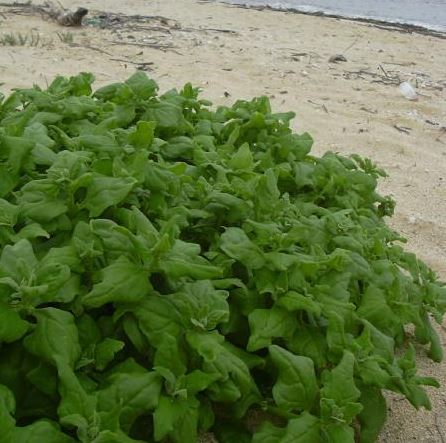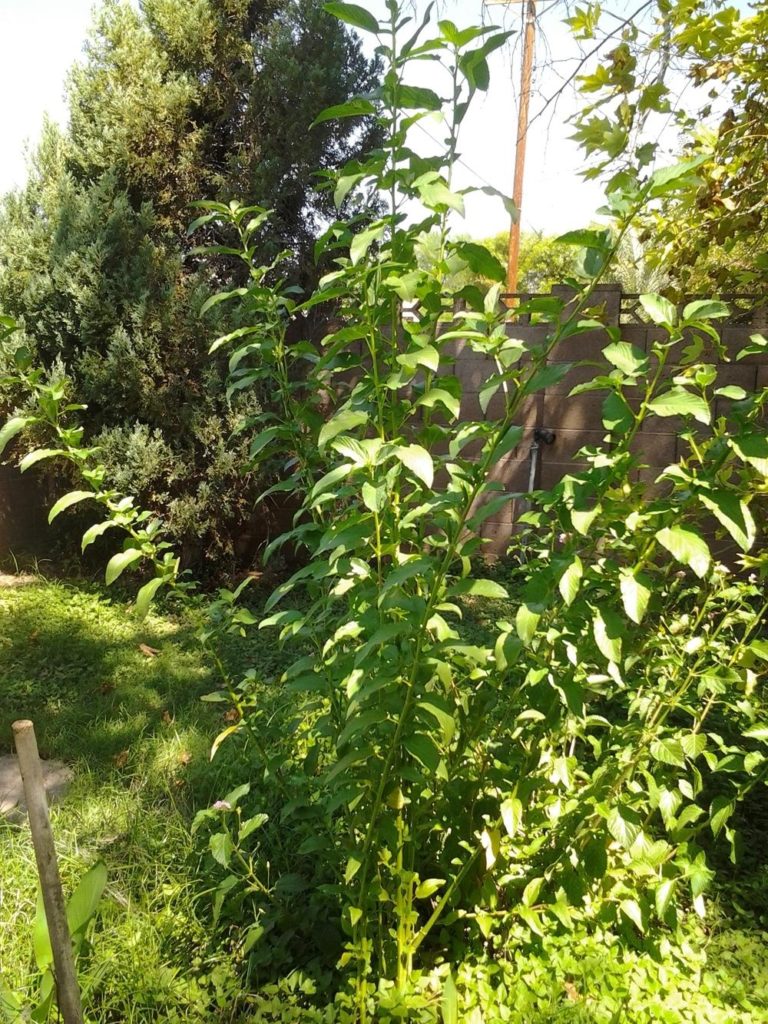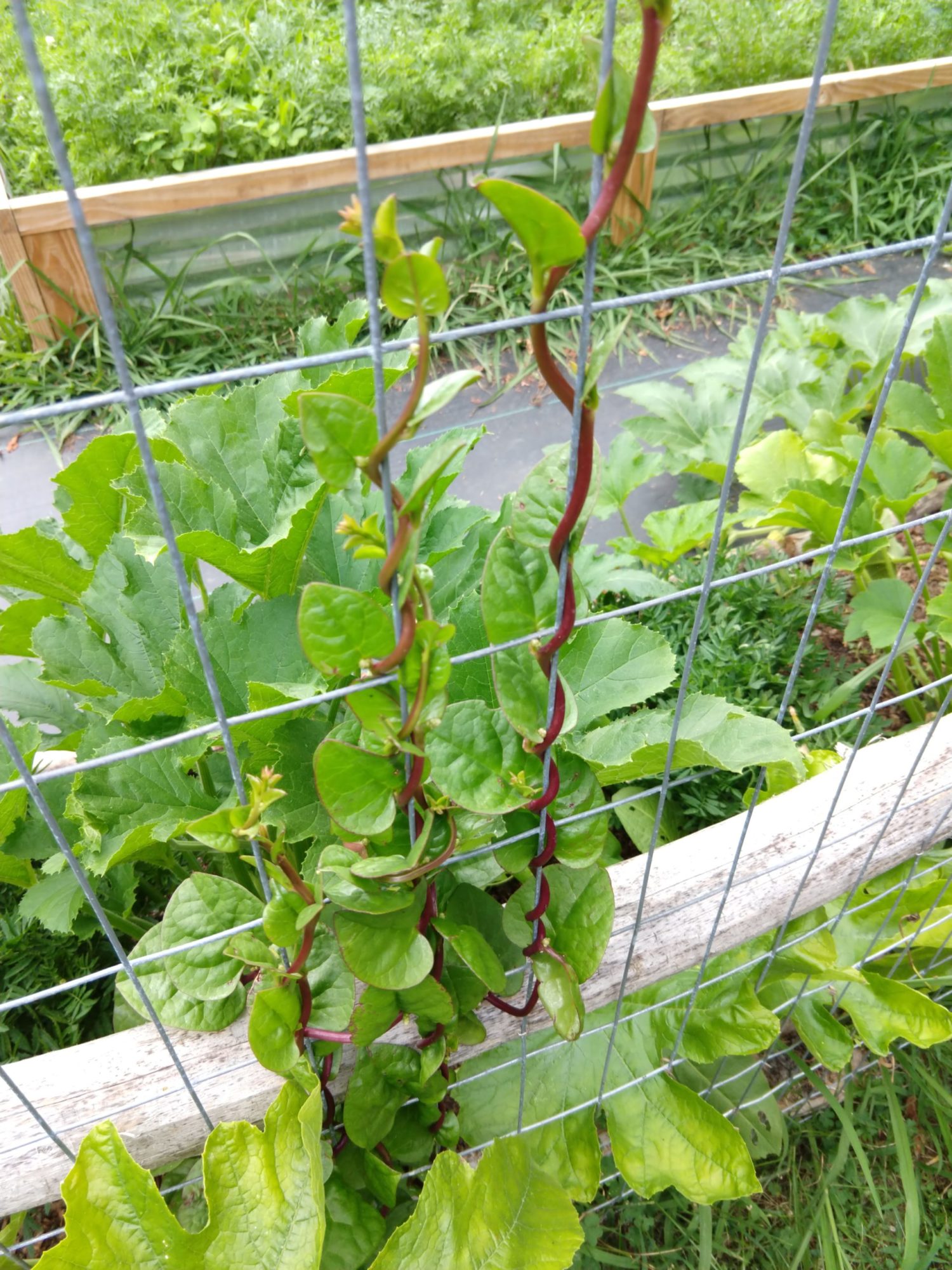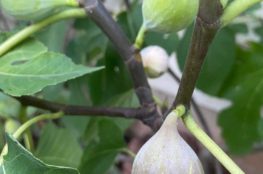As the summer heat intensifies, so does the taste of fresh greens in the garden. Greens, like spinach (Spinacia oleracea), grow best in cool temperatures. Unfortunately, spinach, will bolt to seed from even the slightest exposure to heat. Some gardeners, including me, have trouble growing spinach in general. In past growing seasons I have tried three spinach alternatives: Malabar, New Zealand and Egyptian. They are great in the heat, pest-resistant, and produce large yields with minimal input.
Malabar Spinach
(Basella alba (green stem) & Basella rubra (red stem))
Malabar is not actually a spinach, it is a succulent perennial vine that produces a tasty, nutrient-dense foliage to add to salad or cook down. Malabar is best grown in climates with hot summers. In fact, plant growth slows during the cooler parts of spring and summer before the heat really sets in.
Malabar is hardy only to zone 10 as a perennial and grown in all other zones as an annual crop. This plant is native to tropical regions of Asia, India, Sri Lanka and Indonesia.
Growing
Malabar is extremely frost-sensitive, so it’s important to plant after the risk of frost has passed. Malabar grows most rapidly in fertile, moist, and well-drained soil as long as the average daily temperature is more than 60° F and receives full sun. Malabar usually grows on the ground until it finds something to climb; however, it does best when something is supplied for it to grow up like a post, netting, or a trellis.
Start seeds indoors approximately six weeks before the last frost date. Seeds may take three weeks to germinate. Physically opening the coat of this rock-like seed speeds up germination in a process called mechanical scarification. This is done by using a file, knife, or even sandpaper. Soaking seeds overnight using water, bleach, or hydrogen peroxide also may work.
Eating
Often found in Asian recipes, malabar is eaten raw or cooked down like regular spinach. Being a succulent, most people are turned away by its gelatinous texture. For this reason, most recommend eating the younger foliage because it’s more tender. Raw malabar also has high levels of oxalates like regular spinach, so it may be a problem to those who are sensitive to kidney stones.

New Zealand Spinach
(Tetragonia tetragonoides)
This great, annual heat-tolerant spinach substitute also runs under the following names tetragonia, ice plant, everbearing spinach, Della Nuova Zelanda, everlasting spinach, and perpetual spinach. This plant much like malabar is not a true spinach. New Zealand grows as a bush that can reach a couple feet tall and in an equal foot-print spread.
New Zealand is native to New Zealand, Australia, and parts of Asia, including Japan. It is considered to be invasive in most other regions where it grows, including parts of Africa, South America, and North America.
Growing
New Zealand is also very frost-sensitive and should be planted a couple weeks after immediate risk of frost. It also can be started indoors three to four weeks before the last frost in colder climates. The fruits contain several seeds, which can take 14-21 days to emerge. Soaking seeds 24 hours before planting can speed up germination.
In Zone 6 and warmer, seed directly after the last frost roughly a quarter inch deep in small mounds spaced about two feet apart. Plant a couple seeds in each mound and thin as needed. In colder regions start seeds inside three to four weeks before the last frost, and transplant about two to three weeks after the last frost.
New Zealand also is drought tolerant. However, the best taste comes from plants that are grown in moister conditions. Add mulch to retain moisture and suppress weeds.
Used like spinach in cooking and salads, this frost-tender plant is ready for harvest when it wanes, being productive throughout summer. New Zealand also makes an attractive foliage plant for borders and beds.
Eating
Originally found in recipes from Australia, New Zealand—like malabar—must be boiled before eating due to its high levels of oxalic acid. Personally, I thin it out before boiling or sautéing, and it tastes just like spinach!

Egyptian Spinach
(Corchorus olitorius)
Egyptian is another heat-tolerant spinach substitute that grows like a shrub or bush. Also known as Molokhia, Jute mallow, and Jews mallow. This annual plant can grow a couple feet tall and in an equal foot-print spread.
The origin of Egyptian is debatable; however, it still is commonly grown in Egypt, other parts of Africa, and the Near East. Some historians suggest that the Egyptian name molokheiya means “‘vegetable for a king.” Some writings suggest the plant was consumed as a soup to heal ailments of pharaohs. Egyptian’s fiber also is used for items like sacks and clothing.
Growing
Egyptian also is frost- sensitive and should be planted a couple weeks after immediate risk of frost. Consider planting the plants roughly a half inch deep and spacing them like bushes. This will prevent them becoming shaded too quickly. After 60 days or if they reach two feet high whichever comes first, they are ready to harvest. Cut the leafy greens repetitively throughout the growing season to avoid six feet or more tall plants. Once the temperature dips the fall, the plants will bolt and produce small yellow flowers. The flowers will be replaced by thinner ribbed seed pods, which can be harvested easily once dried on the plant. Each pod contains tons of seeds!
Cultivating Egyptian seeds is easy. In the spring after the last frost, sow them directly into the ground. Alternatively, start seeds indoors about six weeks before the last frost. Egyptian prefers full sun, moisture, and fertile, well-drained soil.
Eating
Egyptian is more commonly boiled down into soups. The younger leaves are more tender and easily eaten raw. The older larger leaves are used as a potherb. Unlike malabar and New Zealand, Egyptian does not have the same succulent-type feel and consistency, nor does it appear to have high levels of oxalic acid. I highly recommend this spinach alternative because it is the most aggressively growing plant and more palatable among the three.


